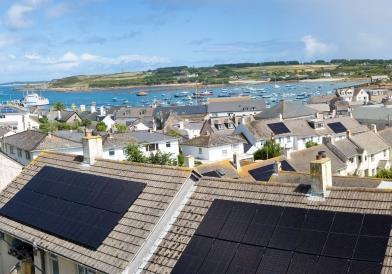
Smart energy solutions development on the Scillies
Home News and events News Smart energy solutions development on the Scillies
The Isles of Scilly’s Smart Islands Programme is delivering smart solutions to energy, waste, water and sewerage services on the Isles of Scilly and Hitachi Europe Ltd has been working with the Smart Islands Partnership since 2015. Together with the Council of the Isles of Scilly, the Duchy of Cornwall, Tresco and the Islands’ Partnership, the first aim of a set of interconnected projects is to deliver more efficient use of locally-produced energy on the islands. The Isles of Scilly Smart Islands Programme aims to increase energy from renewables on the islands to 40%, reduce electricity bills by 40% and replace 40% of vehicles with low carbon or electric alternatives by 2025. (www.smartislands.org)
Eighty-two homes have been fitted with renewable energy generation and energy efficiency equipment since July 2018 on the Isles of Scilly – including 70 homes with solar PV panels on roofs. Five other sites also have solar PV panels and a solar garden has been built at St. Mary’s Airport. Together with new air source heat pumps in some homes, this represents around 460kW of new renewable energy generation installed on the islands since 2018.
To make most efficient use of the new renewable energy generated on the islands, Hitachi Europe, working with Moixa Technology and PassivSystems and part-funded by the European Regional Development Fund, has created a new energy management platform. Harnessing the power of the Internet of Things, it controls residential heat pumps, hot water cylinders, batteries and an EV charger to balance local energy generation and consumption.
The technology solution ensures consumers’ needs, such as heating comfort levels, are not compromised. The system:
- Learns consumption patterns and uses preferences set by the householders; the primary objective is to ensure they have the required level of comfort, hot water, heating and electricity when wanted
- Forecasts when power is generated, stored and used at the sites and homes
- Optimises the islands’ new renewable generation within the constraints of the national energy grid by using and storing energy locally.
The project now has about five months to fully test and analyse the data from the systems under different conditions and simulated scenarios. Teams from Hitachi Europe and the delivery partners – PassivSystems and Moixa Technology – are working closely with Western Power Distribution (WPD), the Council and the Isles of Scilly Community Venture.
The next stage is to introduce electric vehicles to the islands’ new energy system. Electric vehicles, to be used for transport by local residents and businesses, can also be used as batteries, which can feed electricity back into the grid when needed. The systems tells the electric vehicles to top-up when renewable power is in plentiful supply, which allows them to support green energy delivery later during periods of peak electricity demand in homes and businesses.
Known as vehicle-to grid (or V2G), electric cars or vans can help the community switch to cleaner energy because they will be charged using solar power generated locally, they will reduce transport air pollution and support the delivery of green energy.
It is hoped that additional renewable energy generation and innovative ways to manage water and waste will follow in 2020.
Notes
What is the Internet of Things?
The World Wide Web is 30 years old in 2019 and over 4 billion people are connected to it using computers, smart phones and tablets. A world without Internet is unthinkable for Western societies and especially for people under 25, who have never known a world without this technology.
Everyday things – like thermostats, lights, cars and TVs – are being connecting together over networks and to the Internet. These devices not only send data to the Internet but can also be controlled over the Internet using apps and web sites.
On Scilly, the combination of data collection and analysis from solar panels and energy storage using the Internet of Things will help the islands meet their goals to increase use of renewable energy, while cutting energy costs for residents.
Homes
In homes on the islands, the smart devices installed by PassivSystems and Moixa Technology are interconnected, so that energy can be directed into storage in the heating and hot water in a way that maximises the benefits to the home owner. The system uses the 3G and 4G mobile phone network and WiFi to transfer data, and does not use the Government’s national smart meter scheme.
Electric Vehicles (EVs)
Hitachi and project partner, Moixa Technology, have been designing, testing and connecting an Electric Vehicle Energy Management System (EV-EMS) to the islands’ Internet of Things platform. A Nissan eNV200 electric van is connected to the islands’ energy system and testing the use of EVs for local energy storage.
